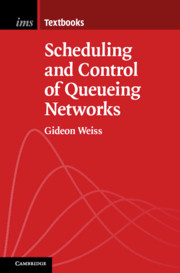Refine search
Actions for selected content:
980 results in Applied probability and stochastic networks
10 - Multi-Class QueueingNetworks, Instability, and MarkovRepresentations
- from Part IV - Fluid Models of Multi-Class Queueing
-
- Book:
- Scheduling and Control of Queueing Networks
- Published online:
- 01 October 2021
- Print publication:
- 14 October 2021, pp 159-174
-
- Chapter
- Export citation
Part IV - Fluid Models of Multi-Class Queueing
-
- Book:
- Scheduling and Control of Queueing Networks
- Published online:
- 01 October 2021
- Print publication:
- 14 October 2021, pp 157-158
-
- Chapter
- Export citation
21 - Load Balancing in the Supermarket Model
- from Part VI - Many-Server Systems
-
- Book:
- Scheduling and Control of Queueing Networks
- Published online:
- 01 October 2021
- Print publication:
- 14 October 2021, pp 360-384
-
- Chapter
- Export citation
Notation
-
- Book:
- Scheduling and Control of Queueing Networks
- Published online:
- 01 October 2021
- Print publication:
- 14 October 2021, pp xi-xii
-
- Chapter
- Export citation
14 - Optimal Control of Transient Networks
- from Part IV - Fluid Models of Multi-Class Queueing
-
- Book:
- Scheduling and Control of Queueing Networks
- Published online:
- 01 October 2021
- Print publication:
- 14 October 2021, pp 236-256
-
- Chapter
- Export citation
6 - Scaling of G/G/1 and G/G/∞
- from Part II - Approximations of the Single Queue
-
- Book:
- Scheduling and Control of Queueing Networks
- Published online:
- 01 October 2021
- Print publication:
- 14 October 2021, pp 83-101
-
- Chapter
- Export citation
Part V - Diffusion Scaled Balanced Heavy Traffic
-
- Book:
- Scheduling and Control of Queueing Networks
- Published online:
- 01 October 2021
- Print publication:
- 14 October 2021, pp 257-258
-
- Chapter
- Export citation
Frontmatter
-
- Book:
- Scheduling and Control of Queueing Networks
- Published online:
- 01 October 2021
- Print publication:
- 14 October 2021, pp i-iv
-
- Chapter
- Export citation

Scheduling and Control of Queueing Networks
-
- Published online:
- 01 October 2021
- Print publication:
- 14 October 2021
3 - Langevin and Fokker–Planck Equations and Their Applications
-
- Book:
- Thinking Probabilistically
- Published online:
- 15 December 2020
- Print publication:
- 17 December 2020, pp 39-66
-
- Chapter
- Export citation
8 - Random Matrix Theory
-
- Book:
- Thinking Probabilistically
- Published online:
- 15 December 2020
- Print publication:
- 17 December 2020, pp 145-183
-
- Chapter
- Export citation
Contents
-
- Book:
- Thinking Probabilistically
- Published online:
- 15 December 2020
- Print publication:
- 17 December 2020, pp v-vii
-
- Chapter
- Export citation
Appendix F - Notation, Notation. . .
-
- Book:
- Thinking Probabilistically
- Published online:
- 15 December 2020
- Print publication:
- 17 December 2020, pp 222-224
-
- Chapter
- Export citation
References
-
- Book:
- Thinking Probabilistically
- Published online:
- 15 December 2020
- Print publication:
- 17 December 2020, pp 225-231
-
- Chapter
- Export citation
2 - Random Walks
-
- Book:
- Thinking Probabilistically
- Published online:
- 15 December 2020
- Print publication:
- 17 December 2020, pp 15-38
-
- Chapter
- Export citation
5 - Noise
-
- Book:
- Thinking Probabilistically
- Published online:
- 15 December 2020
- Print publication:
- 17 December 2020, pp 81-95
-
- Chapter
- Export citation
Frontmatter
-
- Book:
- Thinking Probabilistically
- Published online:
- 15 December 2020
- Print publication:
- 17 December 2020, pp i-iv
-
- Chapter
- Export citation
7 - Anomalous Diffusion
-
- Book:
- Thinking Probabilistically
- Published online:
- 15 December 2020
- Print publication:
- 17 December 2020, pp 133-144
-
- Chapter
- Export citation
6 - Generalized Central Limit Theorem and Extreme Value Statistics
-
- Book:
- Thinking Probabilistically
- Published online:
- 15 December 2020
- Print publication:
- 17 December 2020, pp 96-132
-
- Chapter
- Export citation
Appendix B - A Brief Linear Algebra Reminder, and Some Gaussian Integrals
-
- Book:
- Thinking Probabilistically
- Published online:
- 15 December 2020
- Print publication:
- 17 December 2020, pp 211-213
-
- Chapter
- Export citation
